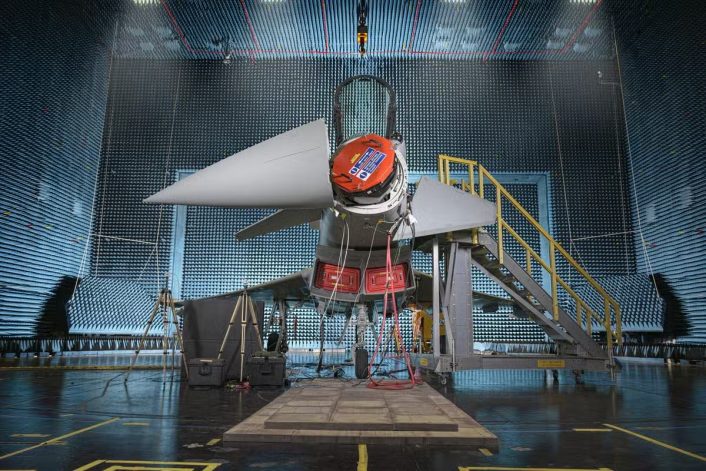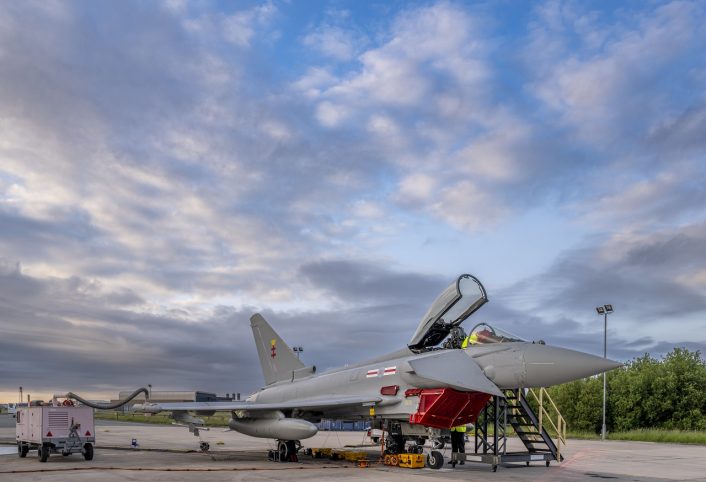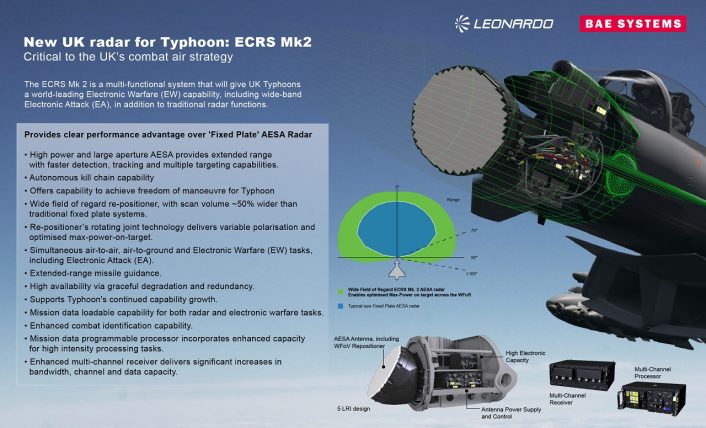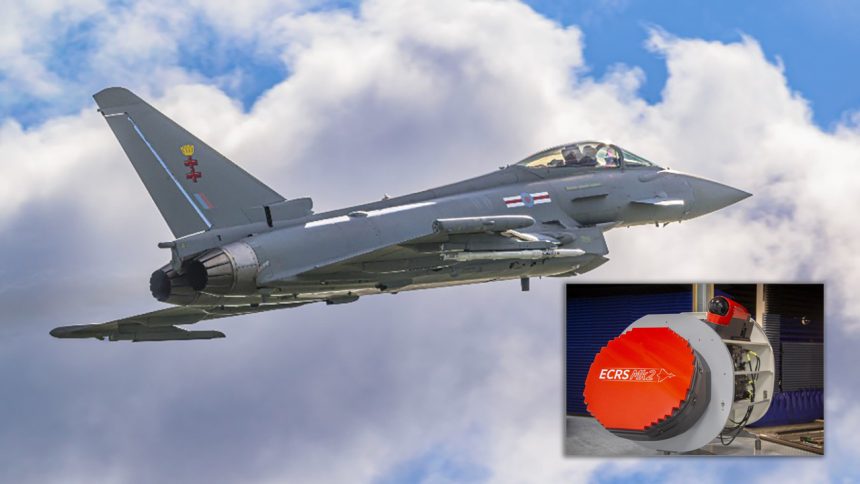The first flight of the new ECRS Mk.2 AESA radar on the Typhoon marks a milestone in the ongoing development of the aircraft to keep it relevant in the next decades, introducing new Electronic Warfare and Electronic Attack capabilities.
A Royal Air Force Eurofighter Typhoon FGR4 flew for the first time with the new advanced ECRS (European Common Radar System) Mk.2 AESA (Active Electronically Scanned Array) radar. The flight was performed on Sep. 27, 2024, from BAE Systems’ Warton facilities with the Typhoon ZK355/BS116 test aircraft, which was designated as the test bed for the new radar.
The first flight follows a programme of integration, ground-based testing delivered through a successful collaboration between MoD Defence Equipment & Support (DE&S), the RAF, and industry leaders BAE Systems and Leonardo. The radar’s latest prototype was first fitted on the aircraft in January 2024 and underwent an extensive programme of ground-based testing which was completed in July.
The flight is the latest milestone in the ongoing development programme for the UK Typhoon, said the RAF, and will strengthen the aircraft’s control of the airspace and provide cutting-edge electronic warfare capabilities making it an even more potent part of the NATO’s frontline fleet. The service also noted that the new aircraft will also provide the Typhoon the ability to locate, identify and suppress enemy air defenses thanks to the new electronic warfare capabilities.
The first flight of the new radar was first announced by U.K.’s Defence Procurement Minister Maria Eagle, who mentioned in a statement in the country’s parliament on Sep. 19 that the flight would happen “in the coming weeks.” Eagle’s statement was a response to a query tabled by British lawmakers on Sep. 9 in the House of Commons, asking about the recent progress by the RAF on the ECRS Mk.2 E-Scan radar procurement.
“The ECRS Mk.2 programme has achieved several positive milestones in the past four months, notably passing the production radar system CDR (Critical Design Review) in Jun. 2024 and the completion of prototype ground testing on a Typhoon trials aircraft in Jul. 2024,” said Eagle to the Parliament. “Teams across the Ministry of Defence and industry are working to meet the major milestone of a first flight of ECRS Mk.2 over the coming weeks.”

ECRS Mk.2 for British Eurofighter Typhoons
Developed by British defense major Leonardo UK, the new ECRS Mk.2 is a powerful AESA radar which can perform air-to-air and air-to-ground detection as well as both Electronic Warfare and Electronic Attack functions, thanks to the multifunction array. These capabilities can give the Typhoon and its pilots an unmatched multi-range detection and survivability in highly contested battle spaces before peer adversaries, according to the info released.
The new radar is a special version of the Captor E AESA radar, or ECRS Mk 1, that is set to equip the Typhoons from Germany, Spain, and of the ECRS Mk 0 that will equip the aircraft of Kuwait and Qatar. The ECRS Mk.2 was developed to initially meet U.K.-only requirements and is a significant advancement over the ECRS Mk.0 AESA radar currently available.
According to a Leonardo’s press release in 2020, the new ECRS Mk2 radar features a revolutionary Multi-Function Array (MFA) and more Transmit-Receive Elements than any other AESA radar, “making Mk 2 the most capable fighter AESA radar in the world, maintaining the same power and precision of traditional radars but also enabling the simultaneous operation of its wide-band Electronic Warfare functionality”.
Leonardo had delivered the first prototype of the ECRS Mk.2 to BAE Systems at its facility in Warton, Lancanshire, in Apr. 2023. That handover was part of a Jul. 2022 US$2.38 billion program to replace the aircraft’s existing Captor M mechanical scan radar.
The radar is expected to be installed on the RAF’s 40 Typhoon FGR4 fighters acquired as part of the Tranche 3.The development of the radar itself can also be considered a part of the much broader GCAP (Global Combat Air Program) between the UK, Italy, and Japan, of which Leonardo and BAE are core members, as the technologies developed for the radar would help the development of the GCAP’s own radar.
“The ECRS Mk2 will equip RAF pilots to locate, identify and suppress enemy air defences, a powerful combination of capabilities that will increase the GCAP’s Typhoon’s lethality and survivability, and the survivability of other friendly forces,” said Mark Stead, Leonardo UK’s senior vice president of radar and advanced targeting at the time of the delivery of the prototype.
As we mentioned, in Jan. 2024 the engineers from BAE Systems and Leonardo UK installed the first ECRS Mk.2 radar onto the Eurofighter Typhoon FGR4 ZK355/BS116 ahead of flight trials. The test bed Typhoon aircraft will fly from the same facility during the flight trials, with more aircraft possibly later added to the program. Prior to that, the prototype radar underwent extensive ground testing.
An RAF Typhoon that’s used for test and evaluation has been fitted with ECRS MK2 AESA radar’s prototype. Maiden flight is expected sometimes this year. https://t.co/jZRxRVfS0n pic.twitter.com/yLHJ0Fc5d1
— Doha (@Doha104p3) January 17, 2024
Ross Wilson, Vice President of Engineering for Leonardo UK’s Radar and Advanced Targeting sector, was quoted saying: “In parallel with the integration work on the prototype system as it approaches flight testing, the ECRS Mk2 production design has also been progressing apace.”
“The radar’s processor, receiver, and antenna power supply and control units have all been re-engineered to further enhance the capacity, capability, and performance of the Mk2 system in alignment with the new antenna and electronic warfare capability,” said Wilson. “These production designs have all passed their critical design review phases, keeping the production programme on schedule.”

Radar Capability
According to AIN, the Mk.2 radar is one of several capability enhancement efforts to keep the Typhoon relevant, especially as it moves toward the Phase 4 enhancements (P4e) upgrade expected by 2029. The package contains a number of new developments, including an automated sensor management capability for all Typhoon radars which will allow it to exploit the capabilities of the new AESA radar to complete multiple simultaneous tasks, while reducing the pilot workload.
Among the enhancements is also the DASS (Defensive Aids Sub-System), which will have a new digital processor offering improved speed, greater memory, and a digital receiver for better discrimination of threat emissions in complex threat sets. RAF aircraft are also equipped with Missile Approach Warning Sensors (MAWS) integrated with DASS.
Generally, AESA radars can themselves become electronic attack weapons, where the pilot can modulate and focus its emission into a single powerful beam. This becomes a high-density microwave weapon of sorts that can ‘fry’ a hostile missile’s or radar’s internal circuitry.
It can be argued that this capability reduces the aircraft’s need to carry separate internal or external EW or SPJ (Self-Protection Jammers) equipment. But given the future high-tech war with Russia or China, both with significant advancements in the electromagnetic spectrum, this would be unlikely.
The ECRS Mk.2’s defining feature is that while being ‘electronically scanned’ as an AESA radar without moving parts, it can additionally be ‘turnable’, like a mechanically scanned one. This is achieved through a ‘re-positioner’, mounted on a single rotating joint, as opposed to the double swashplate arrangement of the Captor-E. According to Leonardo, this capability allows a 50% larger Field of Regard than traditional fixed AESA radars.
The ‘sideway beaming capability’ in AESA radars do not require them to turn in that direction physically, however, by combining electronic and mechanical turning, the ECRS Mk.2 radar gives the plane a broader ‘look’ angle beyond 90 degrees off the jet’s centerline. This offers a new level of situational awareness and maximizes the capability of teaming tactics with fifth generation F-35 stealth fighters.

Typhoon’s future
The Typhoon aircraft is expected to remain in service until 2060 and beyond. A series of further modifications and upgrades form part of the Long Term Evolution roadmap. Future technologies include better datalinks and connectivity, to be compatible unmanned autonomous wingmen drones. According to Leonardo, ECRS Mk.2 is due to be in service with UK RAF Typhoons by the 2030s, and can also be retrofitted to Tranche 2, 3 and new EF aircraft.
The aircraft currently being produced are in the Phase 3 Enhancement (P3E), which is divided in multiple stages. P3EA is itself divided in five more increments under the National Development Programme. As a whole, this stage fully integrates the Brimstone air-to-ground missile and the Meteor air-to-air missile, as well as the Litening 5 targeting pod and an improved human-machine interface in the cockpit.
P3EB introduced the ECRS Mk 0, allowing for its E-Scan functionality, as well as increased multi-role features and the Sniper Advanced Targeting Pod. P3EC further integrates the ECRS Mk 1 radar and increased air-to-ground functionalities. Initially, this stage should have also included the ECRS Mk 2, but it was postponed.
Eurofighter and the NATO Eurofighter & Tornado Management Agency (NETMA) announced in Jun. 2024 the development of the Phase 4 Enhancement (P4E). As the latest upgrade being developed, P4E is intended to take the Typhoon into the future, allowing it to stay relevant and integrate with 5th and even 6th gen aircraft.









